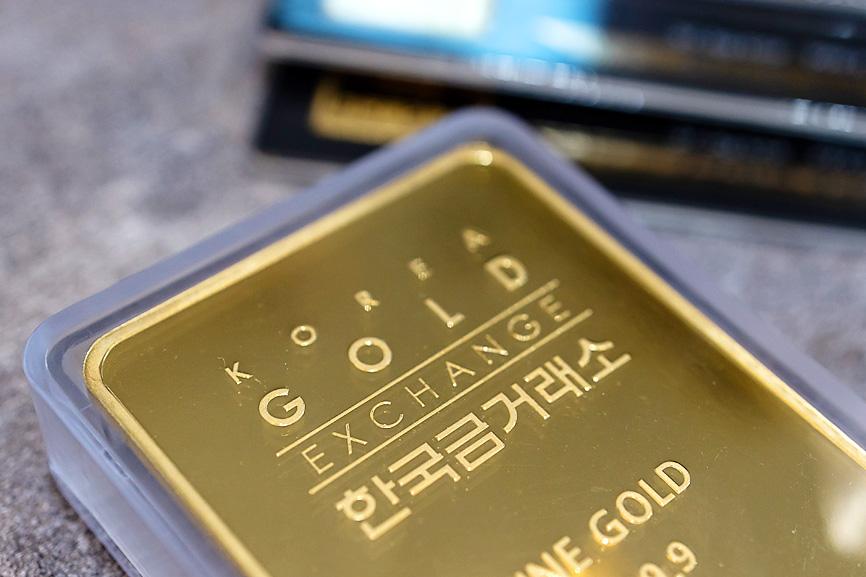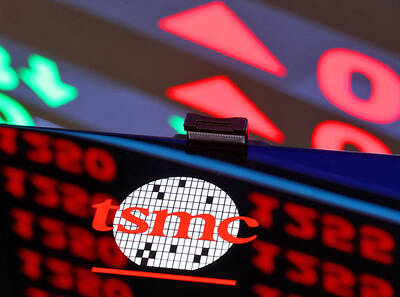Gold posted its biggest weekly gain since July 2020 as the war in Ukraine fueled demand for haven assets.
Investors are assessing the economic fallout from Russia’s invasion of its neighbor, which is disrupting flows of energy, grains and metals.
The resulting surge in oil prices has stoked concerns about global growth and inflation risks.

Photo: Bloomberg
Investors have sought out bullion amid the uncertainty, with holdings in exchange-traded funds backed by the metal climbing to the highest since March last year and hedge fund managers boosting their net bullish gold bets to a 19-month high.
Gold prices extended gains on Friday after a US payrolls report showed that wage growth slowed even as hiring boomed last month. The figures might offer some respite from strong inflationary pressures as the US Federal Reserve gets set to raise interest rates.
The metal “is in a sweet spot for the time being as traders certainly want to have exposure to gold given the war situation in Ukraine,” Ava Trade chief market analyst Naeem Aslam said. Still, the jobs data “has confirmed that the Fed has the green light to increase the interest rate and this is likely to keep the gold price on a tight leash.”
Spot gold on Friday rose 1.7 percent to US$1,972.06 an ounce in New York for an about 4.2 percent weekly gain, the biggest since July 2020.
Bullion for April delivery increased 1.6 percent to settle at US$1,966.60 on the Comex.
Spot palladium advanced 8 percent, topping US$3,000 for the first time since May last year on concerns over potential supply disruptions. The metal is up 27 percent this week. Russia produces about 40 percent of the metal mined globally.
Silver and platinum also surged.
Commodity prices soared the most on record this week as Russia’s invasion of Ukraine threatens key supplies of energy, crops and metals that were already tight as major economies emerged from the COVID-19 pandemic.
The Bloomberg Commodity Spot Index, which tracks 23 futures contracts, climbed 13 percent in the week that ended on Friday. That is the most in data going back to 1960.
Russia’s growing isolation has left traders rushing to secure alternatives to the country’s raw materials, sparking fears of prolonged shortages and accelerating global inflation.
The sanctions, coupled with shipping disruptions in the Black Sea, have brought trade deals with the country to a virtual standstill. Russia is a major supplier of crude, natural gas, grains, fertilizers and metals such as aluminum.
Russia and Ukraine also supply more than one-quarter of world wheat exports, one-fifth of corn sales and a similar share of barley shipments, plus about 80 percent of sunflower oil cargoes.
Europe depends on Russia for about one-quarter of its crude oil and one-third of its natural gas. Russian aluminum typically accounts for about 10 percent of US imports.

SEMICONDUCTOR SERVICES: A company executive said that Taiwanese firms must think about how to participate in global supply chains and lift their competitiveness Taiwan Semiconductor Manufacturing Co (TSMC, 台積電) yesterday said it expects to launch its first multifunctional service center in Pingtung County in the middle of 2027, in a bid to foster a resilient high-tech facility construction ecosystem. TSMC broached the idea of creating a center two or three years ago when it started building new manufacturing capacity in the US and Japan, the company said. The center, dubbed an “ecosystem park,” would assist local manufacturing facility construction partners to upgrade their capabilities and secure more deals from other global chipmakers such as Intel Corp, Micron Technology Inc and Infineon Technologies AG, TSMC said. It

NO BREAKTHROUGH? More substantial ‘deliverables,’ such as tariff reductions, would likely be saved for a meeting between Trump and Xi later this year, a trade expert said China launched two probes targeting the US semiconductor sector on Saturday ahead of talks between the two nations in Spain this week on trade, national security and the ownership of social media platform TikTok. China’s Ministry of Commerce announced an anti-dumping investigation into certain analog integrated circuits (ICs) imported from the US. The investigation is to target some commodity interface ICs and gate driver ICs, which are commonly made by US companies such as Texas Instruments Inc and ON Semiconductor Corp. The ministry also announced an anti-discrimination probe into US measures against China’s chip sector. US measures such as export curbs and tariffs

The US on Friday penalized two Chinese firms that acquired US chipmaking equipment for China’s top chipmaker, Semiconductor Manufacturing International Corp (SMIC, 中芯國際), including them among 32 entities that were added to the US Department of Commerce’s restricted trade list, a US government posting showed. Twenty-three of the 32 are in China. GMC Semiconductor Technology (Wuxi) Co (吉姆西半導體科技) and Jicun Semiconductor Technology (Shanghai) Co (吉存半導體科技) were placed on the list, formally known as the Entity List, for acquiring equipment for SMIC Northern Integrated Circuit Manufacturing (Beijing) Corp (中芯北方積體電路) and Semiconductor Manufacturing International (Beijing) Corp (中芯北京), the US Federal Register posting said. The

India’s ban of online money-based games could drive addicts to unregulated apps and offshore platforms that pose new financial and social risks, fantasy-sports gaming experts say. Indian Prime Minister Narendra Modi’s government banned real-money online games late last month, citing financial losses and addiction, leading to a shutdown of many apps offering paid fantasy cricket, rummy and poker games. “Many will move to offshore platforms, because of the addictive nature — they will find alternate means to get that dopamine hit,” said Viren Hemrajani, a Mumbai-based fantasy cricket analyst. “It [also] leads to fraud and scams, because everything is now